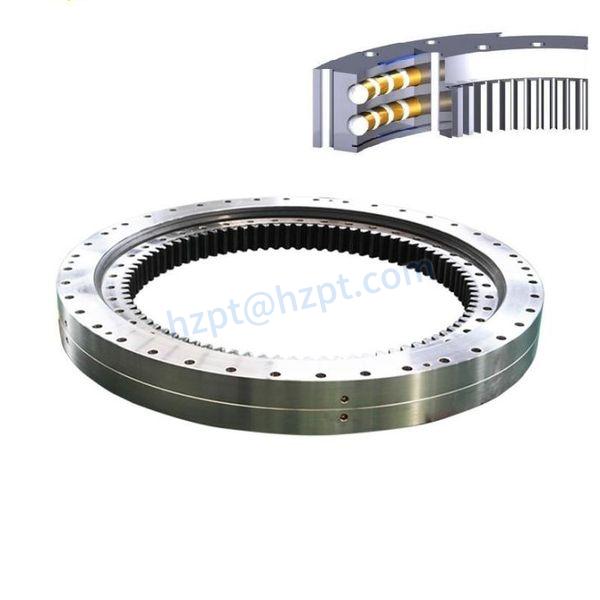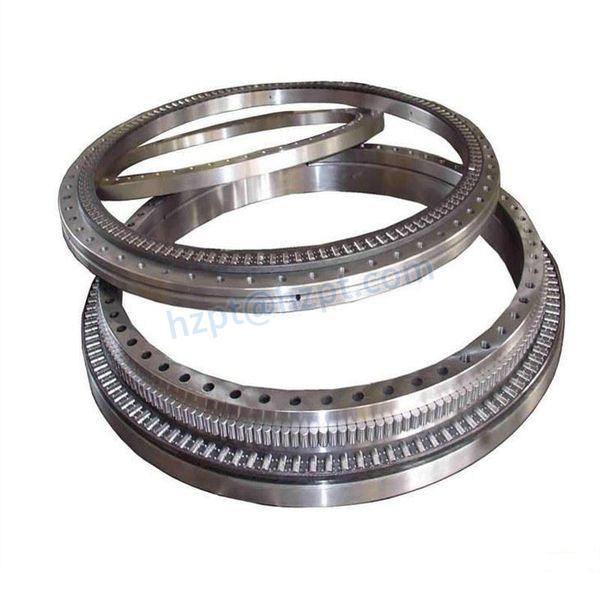Product Description
QW.500.20 External Ring Gears For Crane Slewing Bearing
Four-point contact ball slewing turntable bearings
consist of 2 ring seats. Compact structure, light weight, steel ball and arc track contact at 4 points, can bear axial force, radial force and overturning moment at the same time, has strong dynamic load.
Single row cross roller slewing bearing
Composed of 2 or 3 rings. compact structure, light weight, high manufacturing accuracy, small assembly gap and high requirement for installation accuracy. Rollers are 1:1 cross-arranged.
Can be bear axial force, overturning moment and large radial force at the same time,and widely used in lifting transportation, construction machinery and precesion products.
Double row ball slewing bearings
This kind of bearings can support high static loads with simple structures. They are mainly used in situations with variation load position and direction and continuously rotating. Main applications of this kind of bearings are deck hoisting, mining and material handling etc.
Three row roller slewing bearing
Three row roller bearing CZPT to bear all kinds of loads at the same time, it is the largest 1 of the 4 structural products with large axle and radial dimensions and firm structure. Especially suitable for heavy machinery requiring larger diameter, such as bucket wheel stacker and reclaimer, wheel crane, marine crane, port crane, ladle turret,large tonnage truck crane,heavy machinery and so on.
| Type | • Single row 4 point contact ball slewing bearing • Single row crossed cylindrical roller slewing bearings • Double row ball slewing bearings •Double row Roller/ball combination slewing bearing •Three-Row Roller Slew Ring Bearing |
| Rolling elements | Steel ball / Cylinder Roller |
| Rolling elements Material | GCr5/GCr15SiMn/Customized |
| Bearing Material | 50Mn/42CrMo/42CrMo4V /Customized |
| Cage Material | Nylon/ steel /copper |
| Structure | taper pin , Mounting holes,Inner ring ,grease fitting,load plug, seals , roller ,spacer balls or separators |
| Outer diameter | 50-10000mm |
| Bore size | 50-10000mm |
| Mounting hole | Through hole/Tapped hole |
| Raceway hardness | 55-62HRC |
| Inner and outer ring modulation hardness |
229-269HB/Customized |
| Gear type | No gear ,Internal gear , External gear. |
| Embellish grease | EP2 lithium lubricating grease |
| Certificate | ABS.BV,DNV,ISO9001,GL,3.1,3.2 |
| Application area | Ladle turret,Stacker crane,Bucket wheel machine,Solar heliostat Tracking System,port crane, Cabling machine,tower crane , offshore platform,ferris wheel, Palletizing robot,Rotary metallurgical furnace,can packing machine,Wind blade transporter,shield tunneling machine,tube push bench,excavator |
| Brand Name | LYMC |
| Place of Origin | HangZhou ZheJiang |
| Warranty | 12 months |
| Payment term | T/T is our first choice |
|
Packing details |
1,Filling with anti-rust oil 2.Corved with Plastic paper 3.Corved with kraft paper 4.Corved with Blue tie 5.Put in wooden box |
Product Process
Application:
– Excavators – Drilling rigs – Mining Equipments – Cranes -Offshore Equipments – Vehicles – Machine Tools – Wind Turbines
About Us:
HangZhou MC Bearing Technology Co.,Ltd (LYMC),who is manufacture located in bearing zone, focus on Slewing bearing, cross roller bearing and pinion,Dia from 50mm-8000mm, Our team with technical and full experience in the bearing industry.
*Professional in researching, developing, producing & marketing high precision bearings for 16 years;
*Many series bearings are on stock; Factory directly provide, most competitive price;
*Advanced CNC equipment, guarantee product accuracy & stability;
*One stop purchasing, product include cross roller bearing, rotary table bearing, robotic bearing, slewing bearing, angular contact ball bearing, large and extra large custom made bearing, diameter from 50~9000mm;
*Excellent pre-sale & after sale service. We can go to customers’ project site if needed.
*Professional technical & exporting team ensure excellent product design, quotation, delivering, documentation & custom clearance.
Our Service:
FAQ:
1.Q: Are you trading company or manufacturer ?
A: We are professional slewing bearing manufacturer with 20 years’ experience.
2.Q: How long is your delivery time?
A: Generally it is 4-5 days if the goods are in stock. or it is 45 days if the goods are not in
stock, Also it is according to quantity.
3.Q: Do you provide samples ? is it free or extra ?
A: Yes, we could offer the sample, it is extra.
4.Q: What is your terms of payment ?
A: Payment=1000USD, 30% T/T in advance, balance before shipment.
5.Q: Can you provide special customization according to the working conditions?
A: Sure, we can design and produce the slewing bearings for different working conditions.
6.Q: How about your guarantee?
A: We provide lifelong after-sales technical service.
/* January 22, 2571 19:08:37 */!function(){function s(e,r){var a,o={};try{e&&e.split(“,”).forEach(function(e,t){e&&(a=e.match(/(.*?):(.*)$/))&&1
| Standard or Nonstandard: | Standard |
|---|---|
| Feature: | High Speed, Cold-Resistant, Corrosion-Resistant, Heat-Resistant |
| Sealing Gland: | Sealed On Both Sides |
| Rolling-Element Number: | Single-Row |
| Type: | External Gear |
| Advantage: | Low Noise, Low Vibration,High Precesion |
| Samples: |
US$ 0/Piece
1 Piece(Min.Order) | |
|---|
| Customization: |
Available
| Customized Request |
|---|

How do Environmental Factors such as Temperature and Exposure to Corrosive Substances Impact Slewing Bearings?
Environmental factors, including temperature variations and exposure to corrosive substances, have a significant impact on the performance and longevity of slewing bearings. Here’s how these factors affect slewing bearings:
- Temperature Extremes:
High Temperatures: Excessive heat can lead to premature bearing failure by affecting the lubrication properties, causing thermal expansion, and accelerating wear. Bearings operating at high temperatures require special lubricants and materials that can withstand thermal stresses.
Low Temperatures: Extremely low temperatures can lead to reduced lubricant viscosity, increasing friction and wear. Bearings operating in cold environments might require low-temperature lubricants and materials that maintain their properties in freezing conditions.
- Corrosive Substances:
Moisture and Water: Exposure to moisture and water can lead to rust, corrosion, and erosion of bearing components. This is particularly relevant in marine environments or applications exposed to frequent wet conditions.
Chemical Exposure: Corrosive chemicals and aggressive substances can deteriorate bearing materials and lubricants, leading to accelerated wear and potential structural damage.
Dust and Particles: Dust, dirt, and particles can infiltrate the bearing, causing abrasive wear and increasing the risk of damage to the rolling elements and raceways.
- Effects on Lubrication:
Temperature extremes and exposure to corrosive substances can compromise the effectiveness of lubrication. High temperatures can degrade lubricants, while corrosive environments can contaminate or dilute lubricants, reducing their protective qualities.
- Material Selection:
When designing slewing bearings for specific environments, choosing appropriate materials is crucial. Stainless steels, specialized coatings, and corrosion-resistant materials are often preferred for applications where corrosion is a concern.
- Sealing Solutions:
Effective sealing solutions are essential to protect slewing bearings from moisture, chemicals, and contaminants. Proper sealing helps maintain lubrication integrity and prevents external substances from entering the bearing.
- Maintenance and Inspection:
Regular maintenance and inspections are critical in environments with temperature fluctuations and corrosive exposure. Prompt removal of contaminants, re-lubrication, and replacement of damaged parts can mitigate the effects of these factors.
- Application-Specific Considerations:
Understanding the environmental conditions of the application is essential for selecting the appropriate slewing bearing type, materials, and maintenance practices. Customized solutions might be necessary for extreme environments.
In summary, temperature variations and exposure to corrosive substances can degrade the performance and durability of slewing bearings. Proper material selection, sealing, lubrication, and maintenance practices are vital for ensuring the bearings’ reliability in challenging environmental conditions.

Can you Provide Examples of Industries where Slewing Bearings are Crucial Components?
Slewing bearings play a vital role in various industries due to their ability to handle complex loads and rotational movements. Here are some examples of industries where slewing bearings are crucial components:
- Construction Industry:
Slewing bearings are used in construction machinery such as cranes, excavators, and concrete pumps. They enable the movement of heavy loads, contributing to efficient construction operations.
- Wind Energy Industry:
In wind turbines, slewing bearings allow the rotor blades and nacelle to rotate for optimal wind capture. Their durability and load-bearing capacity are essential for reliable wind turbine operation.
- Mining Industry:
Slewing bearings are employed in mining equipment like stacker-reclaimers and conveyor systems. They facilitate the movement of large quantities of materials, contributing to efficient mining operations.
- Marine Industry:
Slewing bearings are used in ship cranes, davits, and other marine equipment for cargo handling and maintenance tasks. They play a crucial role in maritime operations.
- Aerospace Industry:
Slewing bearings find applications in aerospace equipment like aircraft landing gear systems, satellite antenna deployment mechanisms, and more.
- Manufacturing Industry:
Industrial robots and automation systems utilize slewing bearings for precise rotational movement, enhancing manufacturing processes.
- Material Handling Industry:
Slewing bearings are crucial in material handling equipment such as conveyor systems, container cranes, and automated storage and retrieval systems.
- Energy Industry:
In the energy sector, slewing bearings are used in equipment such as solar trackers, tidal energy platforms, and hydroelectric power plants.
- Medical Industry:
Some medical imaging equipment like CT scanners and MRI machines use slewing bearings for rotational movement, contributing to accurate diagnostics.
- Entertainment Industry:
In theme parks and entertainment venues, slewing bearings are used in amusement rides that require controlled rotational movement.
- Automotive Industry:
Slewing bearings can be found in various automotive applications, such as car turntables and components in heavy-duty vehicles.
These are just a few examples of the diverse industries where slewing bearings are crucial components, contributing to the efficient operation of machinery and equipment.

What Factors Should Be Considered When Selecting a Slewing Bearing for a Specific Application?
Selecting the right slewing bearing for a specific application requires careful consideration of various factors to ensure optimal performance and longevity. Some crucial factors to take into account include:
- Load Requirements: Determine the axial, radial, and moment loads that the slewing bearing will need to support. Choose a bearing with an appropriate load-carrying capacity for the application.
- Space Limitations: Consider the available installation space, both in terms of diameter and height. Choose a slewing bearing that fits within the allocated space without compromising functionality.
- Rotational Speed: Determine the required rotational speed of the bearing. Higher rotational speeds may require bearings with advanced designs and materials to manage heat and wear.
- Environmental Conditions: Assess the operating environment for factors like temperature, humidity, dust, and corrosive substances. Select a bearing with suitable seals and coatings to withstand these conditions.
- Accuracy and Precision: For applications requiring precise positioning, such as robotics or industrial machinery, choose a bearing that offers the necessary level of accuracy in rotation.
- Mounting and Assembly: Consider the ease of installation and any special mounting requirements. Some bearings come with integrated mounting features, simplifying the assembly process.
- Lubrication and Maintenance: Evaluate the lubrication needs of the bearing. Some bearings require periodic maintenance, while others are designed for long-term lubrication.
- Expected Lifespan: Determine the desired lifespan of the bearing in relation to the application’s operational requirements. High-quality bearings with robust construction may offer longer service life.
- Cost-Benefit Analysis: Balance the initial investment with long-term benefits. Consider factors like maintenance costs, downtime, and overall equipment performance.
- Industry Standards: Ensure that the selected slewing bearing complies with relevant industry standards and regulations for safety and quality.
Ultimately, the selection process involves matching the unique requirements of the application with the capabilities of the slewing bearing. Consulting with bearing manufacturers and experts can provide valuable insights to make an informed decision.


editor by CX 2024-05-07
by
Tags:
Leave a Reply